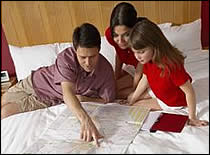Being Prepared for an Earthquake
 While California has been the state most prone to serious earthquakes in recent years, there are many other fault zones in other areas of the United States. For example, geologists and seismologists have predicted a 97 percent chance of a major earthquake in the New Madrid seismic zone of the central United States (including Arkansas, Missouri, Tennessee, and Kentucky) between now and the year 2035. While earthquakes with the power of the one that hit the greater Los Angeles area in January 1994 are fairly rare, less severe earthquakes can interrupt your normal living patterns and cause substantial injury.
While California has been the state most prone to serious earthquakes in recent years, there are many other fault zones in other areas of the United States. For example, geologists and seismologists have predicted a 97 percent chance of a major earthquake in the New Madrid seismic zone of the central United States (including Arkansas, Missouri, Tennessee, and Kentucky) between now and the year 2035. While earthquakes with the power of the one that hit the greater Los Angeles area in January 1994 are fairly rare, less severe earthquakes can interrupt your normal living patterns and cause substantial injury.
During a major earthquake, you may hear a roaring or rumbling sound that gradually grows louder. You may feel a rolling sensation that starts out gently and, within a second or two, grows violent.
OR . . .
You may first be jarred by a violent jolt. A second or two later, you may feel shaking and find it difficult to stand up or move from one room to another.
The real key to surviving an earthquake and reducing your risk of injury lies in planning, preparing, and practicing what you and your family will do if it happens.
Practice Drills
 By planning and practicing what to do if an earthquake strikes, you and your family can learn to react correctly and automatically when the shaking begins. During an earthquake, most deaths and injuries are caused by collapsing building materials and heavy falling objects, such as bookcases, cabinets, and heating units. Learn the safe spots in each room of your home. If you have children, get the entire family to practice going to these locations. Participating in an earthquake drill will help children understand what to do in case you are not with them during an earthquake.
By planning and practicing what to do if an earthquake strikes, you and your family can learn to react correctly and automatically when the shaking begins. During an earthquake, most deaths and injuries are caused by collapsing building materials and heavy falling objects, such as bookcases, cabinets, and heating units. Learn the safe spots in each room of your home. If you have children, get the entire family to practice going to these locations. Participating in an earthquake drill will help children understand what to do in case you are not with them during an earthquake.
Make sure you and your child also understand the school's emergency procedures for disasters. This will help you coordinate where, when, and how to reunite with your child after an earthquake.
During your earthquake drill:
- DROP down onto your hands and knees before the earthquake would knock you down. This position protects you from falling but still allows you to move if necessary.
- COVER your head and neck (and your entire body if possible) under the shelter of a sturdy table or desk. If there is no shelter nearby, get down near an interior wall or next to low-lying furniture that won't fall on you, and cover your head and neck with your arms and hands. Try to stay clear of windows or glass that could shatter or objects that could fall on you.
- HOLD ON to your shelter (or to your head and neck) until the shaking stops. Be prepared to move with your shelter if the shaking shifts it around.
Evacuation Plans
If an earthquake occurs, you may need to evacuate a damaged area afterward. By planning and practicing for evacuation, you will be better prepared to respond appropriately and efficiently to signs of danger or to directions by civil authorities.
- Take a few minutes with your family to discuss a home evacuation plan. Sketch a floor plan of your home; walk through each room and discuss evacuation details.
- Plan a second way to exit from each room or area, if possible. If you need special equipment, such as a rope ladder, mark where it is located.
- Mark where your emergency food, water, first aid kits, and fire extinguishers are located.
- Mark where the utility switches or valves are located so that they can be turned off, if possible.
- Indicate the location of your family's emergency outdoor meeting place.
Establish Priorities
Take time before an earthquake strikes to write an emergency priority list, including:
- important items to be hand-carried by you
- other items, in order of importance to you and your family
- items to be removed by car or truck if one is available
- things to do if time permits, such as locking doors and windows, turning off the utilities, etc.
Write Down Important Information
Make a list of important information and put it in a secure location. Include on your list:
- important telephone numbers, such as police, fire, paramedics, and medical centers
- the names, addresses, and telephone numbers of your insurance agents, including policy types and numbers
- the telephone numbers of the electric, gas, and water companies
- the names and telephone numbers of neighbors
- the name and telephone number of your landlord or property manager
- important medical information, such as allergies, regular medications, etc.
- the vehicle identification number, year, model, and license number of your automobile, boat, RV, etc.
- your bank's or credit union's telephone number, account types, and numbers
- radio and television broadcast stations to tune to for emergency broadcast information
Gather Emergency Supplies
Stock up now on emergency supplies that can be used after an earthquake. These supplies should include a first aid kit, survival kits for the home, automobile, and workplace, and emergency water and food. Store enough supplies to last at least 3 days.
Evacuation Plans
If an earthquake occurs, you may need to evacuate a damaged area afterward. By planning and practicing for evacuation, you will be better prepared to respond appropriately and efficiently to signs of danger or to directions by civil authorities.
- Take a few minutes with your family to discuss a home evacuation plan. Sketch a floor plan of your home; walk through each room and discuss evacuation details.
- Plan a second way to exit from each room or area, if possible. If you need special equipment, such as a rope ladder, mark where it is located.
- Mark where your emergency food, water, first aid kits, and fire extinguishers are located.
- Mark where the utility switches or valves are located so that they can be turned off, if possible.
- Indicate the location of your family's emergency outdoor meeting place.
Establish Priorities
Take time before an earthquake strikes to write an emergency priority list, including:
- important items to be hand-carried by you
- other items, in order of importance to you and your family
- items to be removed by car or truck if one is available
- things to do if time permits, such as locking doors and windows, turning off the utilities, etc.
Write Down Important Information
Make a list of important information and put it in a secure location. Include on your list:
- important telephone numbers, such as police, fire, paramedics, and medical centers
- the names, addresses, and telephone numbers of your insurance agents, including policy types and numbers
- the telephone numbers of the electric, gas, and water companies
- the names and telephone numbers of neighbors
- the name and telephone number of your landlord or property manager
- important medical information, such as allergies, regular medications, etc.
- the vehicle identification number, year, model, and license number of your automobile, boat, RV, etc.
- your bank's or credit union's telephone number, account types, and numbers
- radio and television broadcast stations to tune to for emergency broadcast information
Gather and Store Important Documents in a Fire-Proof Safe
- Birth certificates
- Ownership certificates (automobiles, boats, etc.)
- Social Security cards
- Insurance policies
- Wills
- Household inventory, including:
- list of contents
- photographs of contents of every room
- photographs of items of high value, such as jewelry, paintings, collectors' item
Contact Us:
- Centers for Disease Control and Prevention
1600 Clifton Rd
Atlanta, GA 30333 - 800-CDC-INFO
(800-232-4636)
TTY: (888) 232-6348 - Contact CDC-INFO





